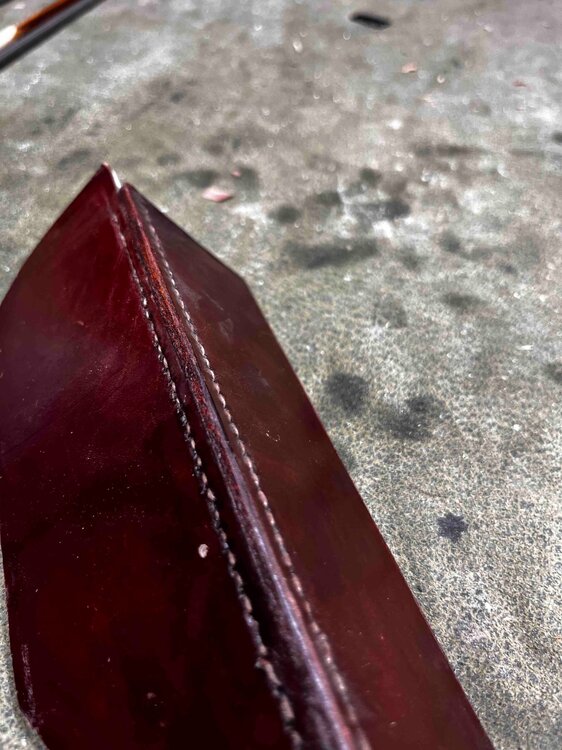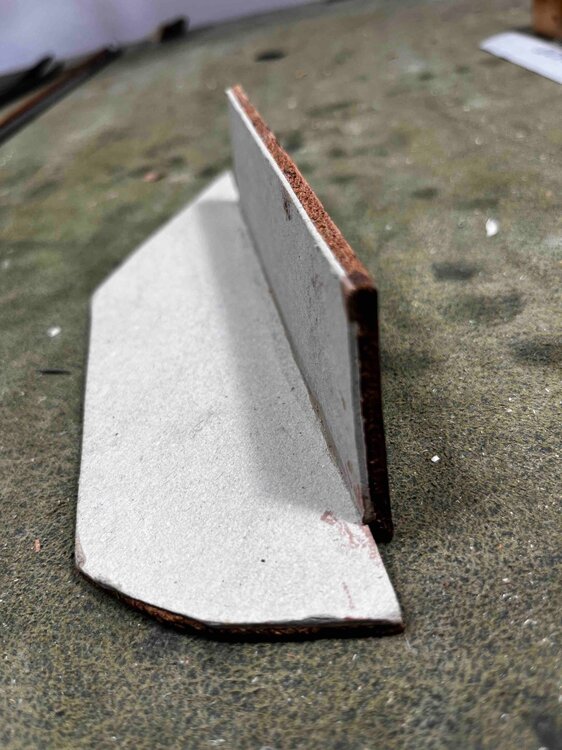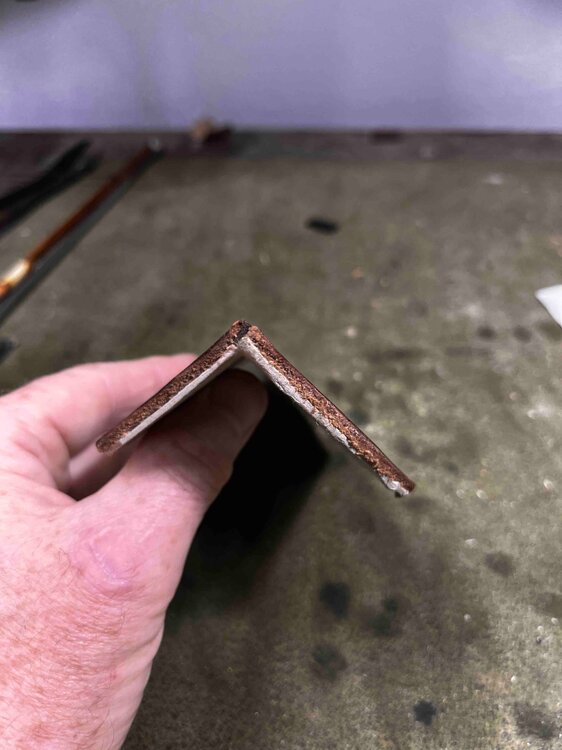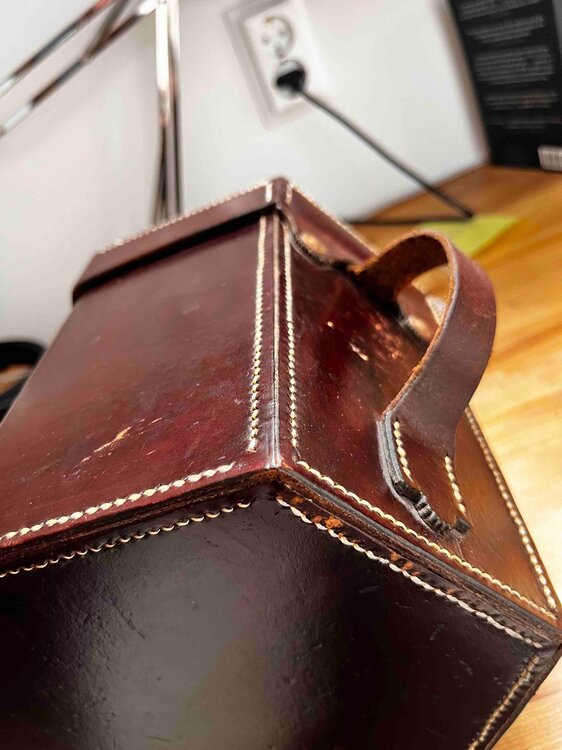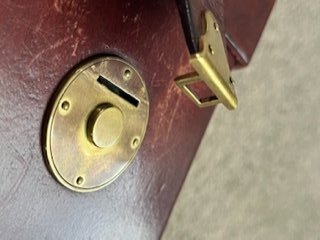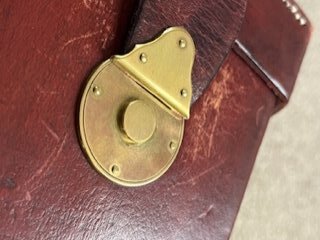-
Posts
686 -
Joined
-
Last visited
Everything posted by adrian brown
-

Reel St Jean - concertina + (unreal) string quartet
adrian brown replied to RatFace's topic in Concertina Videos & Music
Very nice - I really like this! Adrian -
I was at the cinema last night for the latest (and possibly the last) Indiana Jones film and I'm pretty sure I heard an English or possibly even a duet in the "boat" scene. The actor appeared to be playing a single row melodeon, but the sound was pure concertina. Anyone here notice this, or was possibly the player? Adrian
-
I found one of my early test strips in the workshop which will hopefully show my stitching method a little clearer: You can see the relative thickness of the card and leather - as I said in an earlier post, the magic ingredient is the hide glue (rabbit skin) which stiffens the laminate leather/card amazingly. You can see here that the stitching doesn't really go into the card With the jug cases, the most difficult stitching is on the side panels as the angles are much wider than 90°, so the needle goes in at a very oblique angle. In all this stitching, it's really important not to pull the threads too tight, as you can simply pull the thread through the leather. Adrian
-
My baritone Anglo goes to cello C, two octaves below middle c, but then the bottom octave is diatonic apart from the Bb. With Anglos and Duets you can't have everything, or you'd end up with a beast the size of a Chemnitzer. If you want to play solo classical music that is basically in one or two parts, with the odd bit of double-stopping, surely the English is the best way to go? I think the limitation with the English is that with more than two parts, it gets pretty unmanageable fingering wise, but I am prepared to have my head blown off here:-) Because all the notes are there if you want to play a Bach fugue on one of the larger sizes? Adrian
-
Hi Alex and DDF, Great work! DDF: when I made my cases, I punched the holes when the pieces were flat on the bench, with their cardboard backing already glued on, but before bending the sides. It looks like Alex has stitched his leather to the the already jointed box, so yes, I agree the pricking iron would probably demolish the box unless you supported it somehow on the other side. With the Jeffries cases, the stitching goes between the leather panels, so on the ends, it's going through the joint at an angle of about 45° and hardly touching the card on the inside. Using Alex's technique, it looks like the stitching is closer to 90° from the surface, so the leather is joined to the wood construction, rather than (in the case of the Jeffries cases), to the corresponding leather panel. How is it on the Wheatstone style cases you made? I've never had one of those apart enough to see how the stitching goes, put given the proximity of the stitching to the edge of the joints, I suspect it is more like the Jeffries cases, than how Alex has done it? Alex - I'm not saying one way is better than the other, I'm just interested to know how it was done in the past with a wooden as opposed to a card liner? This would have implications for how Steve approaches it, since covering a wooden box with leather would need very different planning than constructing a box from a composite material of leather/card or leather/wood.
-

William Byrd - Sermone Blando
adrian brown replied to adrian brown's topic in Concertina Videos & Music
Thanks! One like this? I've always fancied having a go at making one of these - it would really combine my twin interests of pipes and reeds 🙂 Adrian -
Hi Steve, As Chris said, I have made a few of the Jeffries style jug cases as well as repaired of few Wheatstone cubes. There's a thread from a few years ago here: It sounds as though you are using the right approach - you really need to test your technique at every step of the way before you ruin a nice piece of leather, or destroy the project at the last seam 🙂 I found a the videos by Nigel Armitage very helpful too, but it was nothing like getting to grips with a mock up joint. The Jeffries cases have cardboard stiffener on the inside and as you say, the Wheatstone ones have thin wood. In both cases 🙂 an important part of the stiffness comes from the hide glue - it's truly amazing how this works once it is dry. Other than that a good pricking iron is essential to get your stitching straight and it would help to make up a jig that holds the pieces to be joined in place, while stitching. Nigel shows one of these in his box stitching video and it really helps. Otherwise send me a pm Steve and I'll try to help. Adrian
-

William Byrd - Sermone Blando
adrian brown replied to adrian brown's topic in Concertina Videos & Music
Dammit - how could I have missed that - a day too early 🙂 Thanks for pointing it out Dave! -
With the days getting shorter in the northern hemisphere, and only 174 shopping day until Christmas, maybe time for a short, cozy piece to keep away the winter's chill… I wanted to do this in our local church, but it’s not possible to get in for an evening recording, so some artificial reverb will have to suffice for the atmosphere. Adrian
-

post-Brexit shipping
adrian brown replied to Wolf Molkentin's topic in General Concertina Discussion
Hi Stephen, Is the e-bay shipping cost decided by the individual seller, or is is set by e-bay on a per kilo and destination basis? Of course all companies and individuals are going to have their own tariffs and conditions, but the ones I've dealt with in NI seem to be very keen to exploit their unique status of being both within the UK and the single market. -

post-Brexit shipping
adrian brown replied to Wolf Molkentin's topic in General Concertina Discussion
Hi Wolf, (and Gregor) One thing I have been doing over the last year or so is to find suppliers of British goods in Northern Ireland, (in my case it's mostly tools and machine parts in imperial sizes that I can't find in the EU). Since Northern Ireland has this funny status of still being inside the single market, they can simply deal with the VAT as any other EU country would, and so there are no customs checks or formalities. As a consequence, the shipping is much faster and smoother than sourcing the same products from a UK supplier. I understand that Northern Ireland is enjoying something of a booming economy at the moment, I guess because of its continued ability to trade seamlessly with the EU. Cheers, Adrian -

1/4-comma meantone calculation for Anglos
adrian brown replied to Luke Hillman's topic in General Concertina Discussion
Without wishing to get too pedantic, I feel I should point out that in this example, the instrument is not at A=440Hz, but at A=439.41Hz, making the whole instrument slightly flat of concert pitch. If this can be considered negligible, it begs the question of why you wouldn't simply use the A reference in the first place? I agree Little John, but again I feel I should point out that you can put the wolf anywhere, independently of where you set your reference note. In this example, D is the reference and so G# is directly opposite in the circle of fifths, rather than the Eb, if you start from A. However, there's nothing to stop you going only 2 fifths in one direction and 10 in the other. You can use a reference D and still have Eb as the biggest discrepancy if you so wish. Lastly, where you decide to put the wolf and by extension which notes you would like enharmonic alternatives for, depends first on which chords you regularly use. In my own case, I opted for enharmonic Eb/D#s because I was fed up with having to choose between a clean C minor or B major chord, and wanted them both... Adrian -

1/4-comma meantone calculation for Anglos
adrian brown replied to Luke Hillman's topic in General Concertina Discussion
Thanks Clive, I think that outside of the obvious clashes I highlight in the video, that occur when you push to the limit of meantone tuning, there's probably much less in it than a lot of people think. You can certainly get used to either, or both and it certainly shouldn't be something that gets in the way of the music! As I pointed out in the video, it rather depends on the sort of repertoire you want to play. In folk and pop music where parallel fifths are quite acceptable, the cleaner fifths you get with ET is probably a better option. In Renaissance and Baroque music where thirds were a consonant interval, and parallel fifths an aberration, MT is the obvious choice. Adrian -

1/4-comma meantone calculation for Anglos
adrian brown replied to Luke Hillman's topic in General Concertina Discussion
Probably best to simply share my calculations. A. Meantone temperament calculations for anglo concertina.pdf -

1/4-comma meantone calculation for Anglos
adrian brown replied to Luke Hillman's topic in General Concertina Discussion
Me too Little John! I have been using 1/4 comma meantone on most of my Anglos for many years and they are all tuned from the root A-440Hz. I have Anglos in CG, BbF, GD FC and baritone CG sizes, so if I had not done it this way, they would have been out of tune with each other. With each size, the wolf is simply shifted around the circle of fifths so it falls on the same button combinations on each instrument and I have one enharmonic note which sounds different on the press and draw (eb press - d# draw on a CG) effectively giving me one extra key possibility. As Sean pointed out, if you use a different root on each row, the instrument will be out of tune with itself, so it's a really, really bad idea. I have played many times with other instruments in ET and never had a problem, although you can hear the difference, particularly if you play with another concertina. In a group of more concertinas it's unlikely to be problematic because it's unlikely the concertinas themselves are all perfectly in tune and the blend of the different instruments will hide many discrepancies. Some years ago, I made a rather convoluted video to illustrate the difference between MT and ET, by playing the same pieces on both. (https://youtu.be/HT9fStxlbBQ) I had always meant to follow it up with another showing two or more concertinas playing together. I've somehow never got around to it because of the editing involved, but if there is a feeling this could be interesting, I might try and knock one up. Adrian -
Glad we gave you some food for thought. And in the meantime, if you do want to use a drony effect, try using the buttons you have, it might not be as difficult as you think, once you are used to the concept. Good luck, Adrian
-

Semper Concertina Semper Dolens...
adrian brown replied to adrian brown's topic in Concertina Videos & Music
I felt an urge to have another stab at this, this time playing it on my Dipper baritone. It's very nice to revisit pieces like this after a long gap and comforting to feel how after a short acclimatisation, your fingers seem to move instinctively over familiar button patterns, hopefully giving more time to think about your interpretation. The harmony in this piece is not quite as close as in some of the earlier stuff I've recorded with the baritone and I think it really brings out the "architecture" (for want of a better word) of this instrument. Something for a cold, wet and rainy January weekend? Cheers Adrian -
You beat me to it Alex - I can't imagine why you would want to swap two very useful reversals to duplicate notes you already have in both directions! On the other hand, perhaps Jeremy is talking about a low d in both directions? (a whole tone above the lowest note) In this case I don't think the chamber would be big enough to support such low reeds. Adrian
-

Leather Hard Case repair
adrian brown replied to Tam Paynter's topic in Instrument Construction & Repair
Hope I manged to fix it now? A. -

1926 Wheatstone anglo case repair
adrian brown replied to des tracey's topic in Instrument Construction & Repair
Here's a few photos of one of mine - as you can see it's just a piece of bent brass riveted to the leather with three brass nails. I didn't bother with the engraved line around the edge, but it would be easy to do for somebody with engraving tools. Adrian -
Hi Luke,I mostly find it useful to give an extra emphasis on the last notes of pieces in D minor or dorian. Here’s a few of them I’ve recorded, the first two are on a standard CG followed by a baritone version:The Queen's Almain - La Monicahttps://www.youtube.com/watch?v=ThMNAL1X3PkBelle Qui Tiens Ma Viehttps://www.youtube.com/watch?v=HmUAG8mJ_OIAlso this 5-part renaissance composition: Josquin Des Prez - Plusieurs Regretz https://www.youtube.com/watch?v=kSO_Uzs6oZQ And of course the piece Cohen wrote for me, he didn’t indicate a low finalis but I played it anyway - If you’ve got it, why not flaunt it 🙂 Mr Brown's Gigue https://www.youtube.com/watch?v=cJxjOfeqsEU I am sure I’ve also used it in the past for a C, D, E, F low bass run, but I can’t remember when. Cheers, Adrian
-
Sorry Luke, Only just seen your question from a while back. No, on the "standard" Jeffries 38 layout, that button has a Bb3 draw/ Bb4 press. The duplicating of Bb3 on button 2a allowed me to change it for a very valuable D3 - this is what I mean: https://anglopiano.com/#layout=_30_eFHdJKNMmn.._160_PQTSstVWZX......_15_cGGIijkLMNnh_80_rNoOqpSRuTwURq..IHjlMNOopqrs_110_poSrUTvuYw1x...._145_Kk_125_Li_220_xv (BTW What a fantastic tool that is - did you program it?) I believe John Watcham had his duplicate Bb3 swapped for an F#3 as he found that more useful for certain bass runs. Without wishing to sound pedantic, I would avoid using the term "drone" for any unisonic button on the Anglo layout - it's never really a drone because the note cannot be held past the limit of the bellows, and so any combination of other buttons having the same note would create exactly the same effect. (and otherwise all buttons on the English and ˜duet systems could be considered drones 🙂 ) Martin, I have no idea why the air button is sometimes counted on the Jeffries layout, but not the Wheatstone - a few years ago, some of us here tried to extend Gary's tablature system in a logical to incorporate both the Jeffries and Wheatstone extended layouts, but as far as I know, they've not been used in any publications, so have yet to find acceptance. Cheers, Adrian
-

Leather Hard Case repair
adrian brown replied to Tam Paynter's topic in Instrument Construction & Repair
Here's a photo of how I repaired my wife's similar case: I cut out a strip around the hinge down to the wood with a scalpel and removed the leather. I cut a new piece from an old leather satchel that had a similar colour and thickness and glued it in place using hot hide glue. It's been in use for about 4 years now and looks better in real life than on this photo... However, I see from your post that your case is made from only leather and fabric? Our one (also Wheatstone, but from 1939) has a wooden box covered with +/- 1mm thick leather, so you may have to be more inventive. Perhaps you could glue a new piece of leather on the inside, if you can get the lining off without damaging it? Good luck and I hope this helps, Adrian -
Or a maybe a cello like a viola... Adrian
-
Hi Luke, Thanks for your interesting question which made me ponder how things would be the other way around - which notes (and buttons) I would miss, and what would be the potential gains, if I swapped my Jeffries layout for a Wheatstone 40? In terms of gains, it’s clear that the RH G4 is a great addition, allowing you to play melody runs down to G4 on the right hand side. That said, G4 is normally part of the chord you’d be playing on the LH, so it’s not as crucial as say, having the A4 on the RH. I personally find the C4/C4 LH thumb button combination a bit of a waste - both on Jeffiries and Wheatstone layouts. I’d have the push tuned to an F4, which is far more useful. (Push C4 is of course already on button 3 and if you want to do a sort of drony LH thing, it’s simple enough to swap between button 3 and the thumb button.) However, the two things I would miss the most are the RH pull C5 - I can’t understand why that’s not there, and of course the low D3, which on my layout is where your Bb3 is - my Bb3 being at the end go the middle row. It’s true D3 is not part of the standard Jeffries 38 layout, but because there is room for it, it’s an easy modification and gives you mighty chords when playing in Dm and DMaj. On my RH button 10, I normally have a pull G#5, but on some occasions, I’ll swap this reed in advance for a D#6, because a few pieces I’ve played need it. On the custom Baritone Colin and Rosalie Dipper made for me, they squeezed in an extra button nearby so I could have both... One last comment - have you considered a Jeffries layout with a Wheatstone RH accidental row? I’ve seen a lot of instruments that have had this conversion, in both 30 and 38 button versions, and it might be that an hybrid layout of this sort would work best for you? Cheers, Adrian


